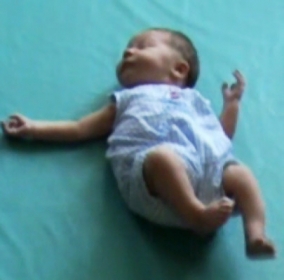|
Newborn abilities are the foundation for new learning
|
During the newborn period infants are adapting to the new social and physical environment. The sensorimotor abilities they acquired while in the buoyant fluid intrauterine environment are harnessed and adapted to the new constraints on movement imposed by gravity and the surfaces they encounter. The limbs have weight and movement of the limbs produces reactive forces as well as momentum which need to be factored into the control of their movements.
Newborn infants when they are awake and alert and lying on a firm surface respond to visual and auditory events in the environment and actively engage in spontaneous movements of the limbs.
The looking, listening and moving provides opportunities for linking what they do to what is seen, heard and felt, creating the perception-action loops that are the basis for making the shift from spontaneous exploratory movements to intentional, goal directed actions that allow the infant to interact with people, things and events in their environment.
Newborn sensorimotor synergies
The newborn infant arrives in the extra-uterine world with numerous movement behaviours that support their survival, interaction with the environment and ability to learn from experience.
Movement behaviours present at birth are organised as sensorimotor synergies which can be adapted to changing circumstances and events in the environment.
Previously these sensorimotor symergies were described as reflexes, but more recent studies have shown that the synergies involve complex patterns of movements adapted to ongoing changes in the environment (von Hofsten 2018).
Rooting response
Rooting refers to the infant's tendency to turn the head towards a mechanical stimulus applied to the area around the mouth, which facilitates latching onto the nipple for feeding.
Traditionally rooting was considered to be a stereotyped response to a stimulus (reflex), however Odent (1979) showed that rooting does not just involve movements of the head and mouth but also exploratory movements of the whole body with all the senses involved.
Rooting is not elicited when the infant touches herself (Rochat & Hespos, 1999).
Sucking mechanism
“Skilled sucking relies on a complex interaction of muscle contractions that are prospective in nature. Within a day or so after birth the sucking system functions with amazing accuracy.
There are two phases of sucking, one that creates a temporary vacuum in the mouth region and one the releases the milk from the nipple. A well-functioning sucking action relies on adjusting the change in sucking pressure to the flow of milk that is different from suck to suck. In other words, the newborn infant has to sense the upcoming flow of milk and adjust the sucking pressure to it ahead of time.”
“Craig and Lee (1999) found that neonates adjusted their sucking action in a precise and prospective way indicating that they anticipated the upcoming flow of milk.” (Von Hofsten 2018)
Ability to lift and turn head to keep airway clear
When placed face down on a supporting surface newborn infants will lift and turn their heads to clear the airway. Lifting and turning the head involves not only the neck muscles, but also requires some adjustments in the UE and trunk muscles to provide some stability to support the neck movements.
Limb movement synergies at birth
The multi-segmented structure of the body provides the basis for producing the varied movement patterns seen in human actions. To simplify control of the many degrees of freedom inherent in a multi-segmented body, spontaneous infant movements are constrained and organised into synergies (von Hofsten, 1989).
During the neonatal period the lower extremity synergy is characterised by intralimb coupling of hip and knee flexion or extension. The upper limb synergy combines shoulder and elbow extension with extension of the fingers and wrist.
Over the first few months as the infant explores different ways of interacting with the environment and as the frontal motor areas become more active, the strong intralimb coupling lessens as movement are adapted to allow for effective interaction with the environment.
Behavioral states and movement
When awake infants shift between several different states which affect the organization of their spontaneous movements.
In an alert but quiet state movement is minimal. The alert but quiet state is often associated with visual attention to the infant's own hand or the face of a social partner and other interesting visual stimuli in the environment.


In the alert and active state infants engage in bouts of vigorous spontaneous movements of the limbs.
When distressed the infant's movements are ongoing and very vigorous. Jitters and trembling may be present in the limbs.
Observation
Watch these two videos and identify the different newborn behaviors,as described above, that provide the substrate for new learning
Will 5 days: movement when distressed
Will 5 days: attention and movement behavior
Bibliography
The Neonatal Neurological Examination: Improving Understanding and Performance
https://torontocentreforneonatalhealth.com/wp-content/uploads/2020/06/Neonatal-Neuro-Exam.pdf